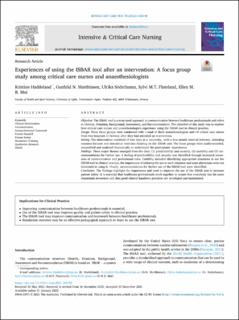Experiences of using the ISBAR tool after an intervention: A focus group study among critical care nurses and anaesthesiologists
Haddeland, Kristine; Marthinsen, Gunhild Nordbø; Söderhamn, Ulrika; Flateland, Sylvi Monika; Moi, Ellen Benestad
Peer reviewed, Journal article
Published version
Permanent lenke
https://hdl.handle.net/11250/3045820Utgivelsesdato
2022Metadata
Vis full innførselSamlinger
Originalversjon
Haddeland, K., Marthinsen, G. N., Söderhamn, U., Flateland, S. M. T. & Moi, E. B. (2022). Experiences of using the ISBAR tool after an intervention: A focus group study among critical care nurses and anaesthesiologists.Intensive & Critical Care Nursing, 70, 1-7. https://doi.org/10.1016/j.iccn.2021.103195Sammendrag
Objective The ISBAR tool is a structured approach to communication between healthcare professionals and refers to Identity, Situation, Background, Assessment, and Recommendation. The objective of this study was to explore how critical care nurses and anaesthesiologists experience using the ISBAR tool in clinical practice. Design Three focus groups were conducted with a total of three anaesthesiologists and 14 critical care nurses from two hospitals in Norway after they had attended an intervention. Setting The intervention consisted of two days at a university, with a four-month interval between, attending resource lectures and simulation exercises focusing on the ISBAR tool. The focus groups were audio-recorded, transcribed and analysed thematically to understand the participants' experiences. Findings Three major themes emerged from the data: (1) predictability and security, (2) usability and (3) recommendations for further use. A feeling of predictability and security was identified through increased awareness of communication and professional roles. Usability included identifying appropriate situations to use the ISBAR tool in clinical practice, the importance of tailoring the use to each situation and some physicians were not interested in using it. Finally, recommendations for further use of the ISBAR tool were identified. Conclusion The findings highlight the importance and need to improve the use of the ISBAR tool to increase patient safety. It is essential that healthcare professionals work together to ensure that everybody has the same situational awareness and that good clinical handover practices are developed and maintained.

